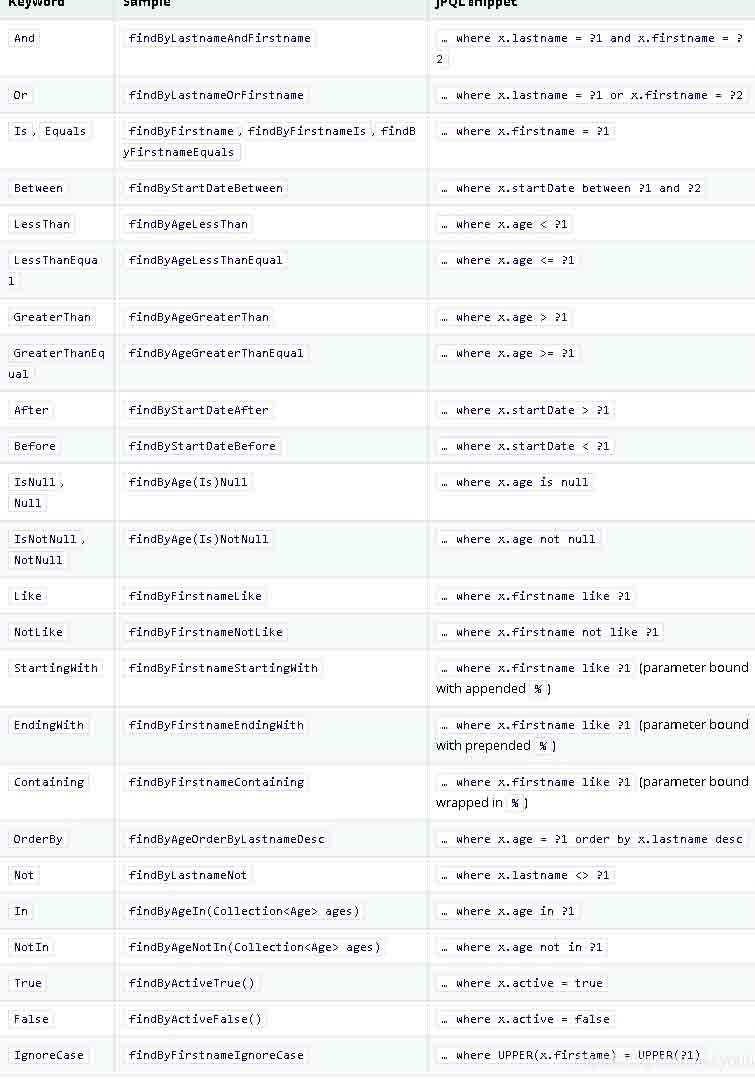梳理了一遍JPA的方法命名语法,记录一下,以便后续备查。
注:本文不介绍JPL语法,版本为spring-data-jpa-2.3.0.RELEASE。
假设实体类名为 aaa,且定义如下:
import lombok.Data;
import javax.persistence.Entity;
import javax.persistence.Id;
@Entity
@Data
public class aaa {
@Id
private long id;
private long restId;
private int dishHour;
private int num;
}
对应的仓储层接口定义:
import org.springframework.data.jpa.repository.JpaRepository;
import org.springframework.stereotype.Repository;
import javax.transaction.Transactional;
import java.util.List;
@Repository
public interface aaaRepository extends JpaRepository<aaa, Long> {
int countByDishHourAndRestId(int hour, long restId);
boolean existsByDishHourAndRestId(int hour, long restId);
List<aaa> findByDishHourAndRestId(int hour, long restId);
aaa findTopByDishHourAndRestId(int hour, long restId);
@Transactional
int deleteByDishHourAndRestId(int hour, long restId);
}
int countByDishHourAndRestId(int hour, long restId); int countaaaByDishHourAndRestId(int hour, long restId); int countaaasByDishHourAndRestId(int hour, long restId); int countAllByDishHourAndRestId(int hour, long restId);
上面这4个方法是一样的,对应的SQL如下:
select count(id) from aaa where dishHour=? and restId=?
下面这种定义,没有意义,知晓一下就好:
int countDistinctByDishHourAndRestId(int hour, long restId);
对应SQL如下,如果表中有主键,功能跟countBy是一致的,浪费性能:
select distinct count(distinct id) from aaa where dishHour=? and restId=?
boolean existsByDishHourAndRestId(int hour, long restId); boolean existsaaaByDishHourAndRestId(int hour, long restId); boolean existsaaasByDishHourAndRestId(int hour, long restId); boolean existsAllByDishHourAndRestId(int hour, long restId);
上面这4个方法是一样的,对应的SQL如下:
select id from aaa where dishHour=? and restId=? limit 1
下面这种定义,没有意义,知晓一下就好:
boolean existsDistinctByDishHourAndRestId(int hour, long restId);
对应SQL如下,功能跟existsBy是一致的,多余:
select distinct id from aaa where dishHour=? and restId=? limit 1
List<aaa> findByDishHourAndRestId(int hour, long restId); List<aaa> findaaaByDishHourAndRestId(int hour, long restId); List<aaa> findaaasByDishHourAndRestId(int hour, long restId); List<aaa> findAllByDishHourAndRestId(int hour, long restId); List<aaa> getByDishHourAndRestId(int hour, long restId); List<aaa> getaaaByDishHourAndRestId(int hour, long restId); List<aaa> getaaasByDishHourAndRestId(int hour, long restId); List<aaa> getAllByDishHourAndRestId(int hour, long restId); List<aaa> queryByDishHourAndRestId(int hour, long restId); List<aaa> queryaaaByDishHourAndRestId(int hour, long restId); List<aaa> queryaaasByDishHourAndRestId(int hour, long restId); List<aaa> queryAllByDishHourAndRestId(int hour, long restId); List<aaa> readByDishHourAndRestId(int hour, long restId); List<aaa> readaaaByDishHourAndRestId(int hour, long restId); List<aaa> readaaasByDishHourAndRestId(int hour, long restId); List<aaa> readAllByDishHourAndRestId(int hour, long restId); List<aaa> streamByDishHourAndRestId(int hour, long restId); List<aaa> streamaaaByDishHourAndRestId(int hour, long restId); List<aaa> streamaaasByDishHourAndRestId(int hour, long restId); List<aaa> streamAllByDishHourAndRestId(int hour, long restId);
上面这20个方法是一样的,对应的SQL如下:
select id,dishHour,num,restId from aaa where dishHour=? and restId=?
下面这种定义,没有意义,知晓一下就好:
List<aaa> findDistinctByDishHourAndRestId(int hour, long restId);
对应SQL如下,如果表中有主键,功能跟findBy是一致的,多余:
select distinct id,dishHour,num,restId from aaa where dishHour=? and restId=?
aaa findFirstByDishHourAndRestId(int hour, long restId); aaa findTopByDishHourAndRestId(int a, long b); aaa getFirstByDishHourAndRestId(int hour, long restId); aaa getTopByDishHourAndRestId(int a, long b); aaa queryFirstByDishHourAndRestId(int hour, long restId); aaa queryTopByDishHourAndRestId(int a, long b); aaa readFirstByDishHourAndRestId(int hour, long restId); aaa readTopByDishHourAndRestId(int a, long b); aaa streamFirstByDishHourAndRestId(int hour, long restId); aaa streamTopByDishHourAndRestId(int a, long b);
上面这10个方法是一样的,对应的SQL如下:
select id,dishHour,num,restId from aaa where dishHour=? and restId=? limit 1
注:返回值也可以改成List<aaa>,但是SQL不变,返回的数组也只有一条数据
下面这种定义,没有意义,知晓一下就好:
List<aaa> findDistinctFirstByDishHourAndRestId(int hour, long restId);
对应SQL如下,如果表中有主键,功能跟countBy是一致的,多余:
select distinct id,dishHour,num,restId from aaa where dishHour=? and restId=? limit 1
@Transactional int deleteaaaByDishHourAndRestId(int a, long b); @Transactional int deleteaaasByDishHourAndRestId(int a, long b); @Transactional int deleteAllByDishHourAndRestId(int a, long b); @Transactional int deleteByDishHourAndRestId(int a, long b); @Transactional int removeaaaByDishHourAndRestId(int a, long b); @Transactional int removeaaasByDishHourAndRestId(int a, long b); @Transactional int removeAllByDishHourAndRestId(int a, long b); @Transactional int removeByDishHourAndRestId(int a, long b);
上面这8个方法是一样的,对应有2条SQL,如下:
select id,dishHour,num,restId from aaa where dishHour=? and restId=? delete from aaa where id=?
注:先SELECT查找主键,再进行删除,所以必须在方法前加注解Transactional,提供事务,否则会抛异常。
下面这种定义,没有意义,知晓一下就好:
int deleteDistinctByDishHourAndRestId(int hour, long restId);
对应SQL如下,如果表中有主键,功能跟deleteBy是一致的,多余:
select distinct id,dishHour,num,restId from aaa where dishHour=? and restId=?
注1:方法By后面的语法,可以参考下图,或官方文档:

注2:JPA Query注解问题:
SQL里可以用 #{#entityName} 占位符,替代手写表名,如:
@Query(value = "select * from #{#entityName} where 1=2", nativeQuery = true)
aaa selectXXX();
INSERT、UPDATE、DELETE这3种DML操作,返回值只能是void、int、long,且必须增加2个注解,例如:
// 返回值不是void、int、long,报错:
// Modifying queries can only use void or int/Integer as return type!
// 不加 Transactional 报错:
// javax.persistence.TransactionRequiredException: Executing an update/delete query
@Transactional
// 不加Modifing 报错:
// Can not issue data manipulation statements with executeQuery().
@Modifying
@Query(value = "update #{#entityName} set num=num+1 where id=6", nativeQuery = true)
int doupdate();
注3:JPA原生方法列表:
List<T> findAll(); List<T> findAll(Sort var1); List<T> findAllById(Iterable<ID> var1); <S extends T> List<S> saveAll(Iterable<S> var1); void flush(); <S extends T> S saveAndFlush(S var1); void deleteInBatch(Iterable<T> var1); void deleteAllInBatch(); T getOne(ID var1); <S extends T> List<S> findAll(Example<S> var1); <S extends T> List<S> findAll(Example<S> var1, Sort var2);
以上为个人经验,希望能给大家一个参考,也希望大家多多支持。